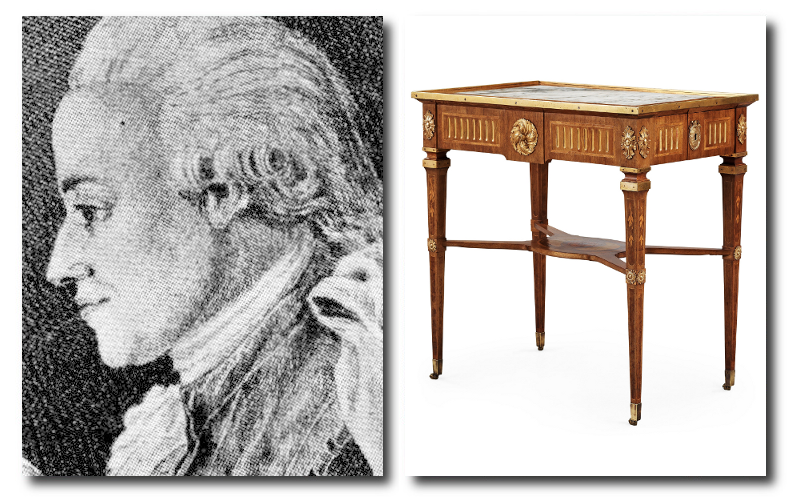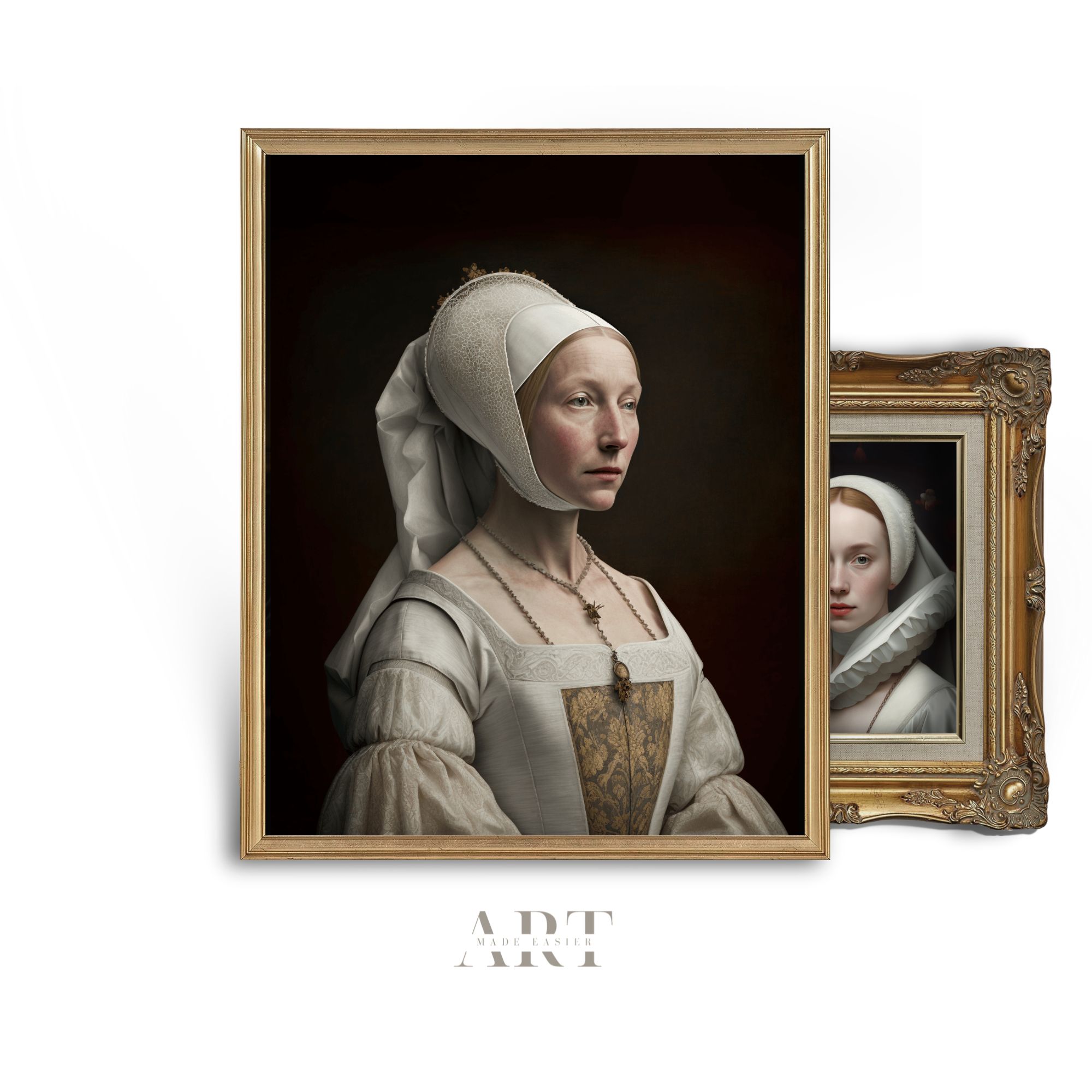7 Of The Most Famous Swedish Furniture Designers And Decorators
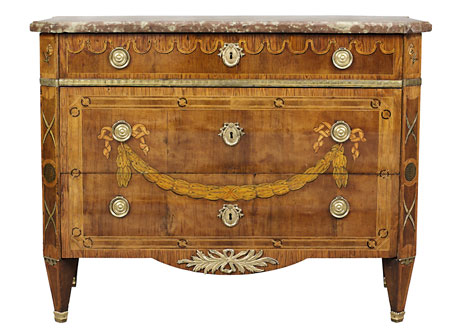 Bureau of Jonas Hultsten, champion in Stockholm 1773-1794. Veneered with rosewood, mahogany, maple and stained hardwood and slice of red limestone.
Bureau of Jonas Hultsten, champion in Stockholm 1773-1794. Veneered with rosewood, mahogany, maple and stained hardwood and slice of red limestone.
Jonas Hultsten
Jonas Hultsten was born in 1742 and was known in Sweden as a famous furniture maker. Hultsten completed his apprenticeship with Kristian Waistband in Stockholm, and earned the title of champion in his trade. He began working within the Rococo style, but was influenced by Georg Haupt who designed around the Gustavian style. Haupt influenced his choice of motifs in wood inlays, but after his death, he developed an eye which was all his own. He is best known for creating a design with a grid pattern featuring a small flower in each box. An example can be seen in the Princess’s bedchamber at Gripsholm Castle with a chest of drawers made around 1780.
Jonas Hultsten, Seen At Bukowskis.com
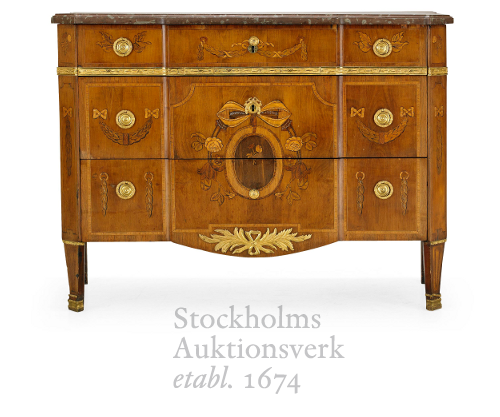 Jonas Hultsten, Seen At Auktionsverket.se
Jonas Hultsten, Seen At Auktionsverket.se
Johan Åkerblad
Åkerblad was one of Sweden’s most prominent and prolific mirror maker, working mainly in the Rococo and Gustavian styles. Johan Åkerblad’s mirrors were decorated with beading around the glass and classic decorations seen in the Gustavian styles such as the bow. Johan Åkerblad’s mirrors can be found today, and demand premium prices for their craftsmanship.
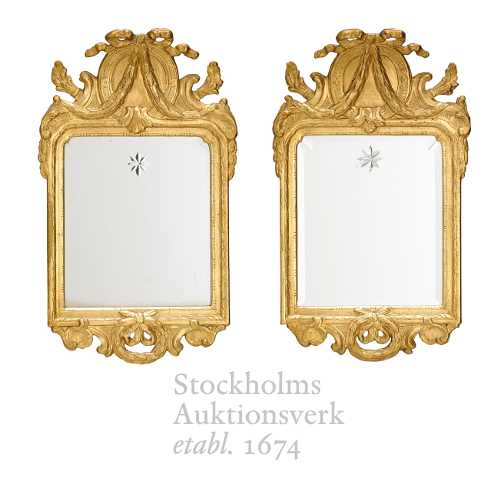 Johan Åkerblad, Seen At Auktionsverket.se
Johan Åkerblad, Seen At Auktionsverket.se
Johan Åkerblad Seen At Bukowskis Market
Gustav III’s collapsible bed by Georg Haupt, located at Drottningholm Palace-
Picture Credit- godsochgardar.se
Georg Haupt
Georg Haupt, born in 1741 in Stockholm , died September 18 1784 , was a Swedish craftsman and one of the most famous designers of Gustavian furniture. He became a cabinetmaker to King Adolphus Frederick in 1769, and was known as a master carpenter and burgess in Stockholm in 1770 and 1771.
Haupt was the son of a Nuremberg carpenter, and learnt his trade as an apprentice of Johan Conrad Eckstein in Stockholm. His grandfather was an art maker Jurgen Haupt who in the 1660s immigrated to Stockholm from Nuremberg. He travelled as a journeyman to Amsterdam, Paris and London, and learned the trade during a period when the French rococo had been quite fashionable in Swedish furniture design. When he arrived in Paris in 1764, the neoclassical style, under the name Louis XVI was gaining popularity. Many speculate he was employed in the workshop of Simon Oeben, the brother of the better-known Jean-François Oeben.
One of his most famous piece of furniture was Gustav IV Adolf’s cradle. It was King Adolf Fredrik’s gift to his wife, Louisa. It got its place in the marble cabinet at Drottningholm Palace. His first royal commission was to be a desk intended as a gift for the Queen. After some pressure from the King, the Stockholm carpentry guild allowed him to use the completed piece to qualify as a master, even though journeymen older than him waiting for their turn. When he was allowed into the Guild in 1770, he became a burgess in Stockholm the following year. He establishing a workshop in rented premises at Trumpetarbacken, Norrmalm, which allowed him to employ four journeymen and a few apprentices to produce furniture for the royal court and the Swedish social and economic elite.
A signed Haupt agency was sold in 1989 to Bukowski to 12.2 million kroner at the Smaland financial man Roy Gustafsson, making it Sweden’s second most expensive antique.
Article Credit – Wikipedia
Sophisticated neoclassical interior of the Old Town in Stockholm by Louis Masreliez.- Picture Credit- Godsochgardar.se
Louis Masreliez
Louis Masreliez (Adnen Louis Masreliez) born in 1748 in Pans, died March 19 in 1810 , was a Swedish painter, graphic artist and interior designer.
He was the older brother of ornament sculptor Jean Baptiste Masreliez and son of Jacques Adrien Masreliez, also an ornamental sculptor, invited to Sweden from France to assist in the construction of the Royal Palace .
Louis Masreliez came to Sweden in 1753, and began his education at Scribbles Academy at age 10. When the drawing academy was no training in painting , Masreliez began his studies at Lorens Gott’s workshop. In 1769 he was awarded a government scholarship, which he used for a study trip to Paris and Bologna. He returned to Sweden in 1782, where he became a member of the Academy of Art and the following year professor of history painting . His breakthrough work included Gustav Ill’s Pavilion at Haga Park.
Source- Wikipedia
Gottlieb Iwersson
Gottlieb Iwersson, born 1750. died 1813, and was known to be a famous Swedish furniture maker. He was born in Malmo , the second son of alderman in Malmo carpenters office Olof Iwersson and began his career in 1766 by an apprenticeship to his father.
In 1769, he moved to Stockholm, and became a master in 1778. Mastarprovet was a desk that was manufactured for Gustav III’s behalf, a magnificent piece of furniture with vertical facade, decorated with the Swedish national coat of arms in marquetry and extensive decorations in
gilt bronze. He worked with Louis Masreliez , and designed a desk for Gustav IV Adolf. He also worked with interior Arvfurstens palace.
He opened his own workshop in the neighborhood Ox in Stockholm in 1779, he was forced to close in 1812 due to increasing health problems. Iwerssons more famous works originated at the end of his career when he designed in the late Gustavian style, which saw veneer with dark woods like mahogany and simple brass fittings that incorporated both English and French influences.
Source- Wikipedia
Gustavus Ditzinger
Gustavus Ditzinger, was born in 1760, and died 1800. He was known as a famous Swedish furniture-maker. Ditzinger studied under Georg Haupt from 1776 and became a journeyman in 1782. He worked for Haupts widow Sara from 1784 and married her in 1789.
Ditzinger received a title of master carpenter in Stockholm in 1788. He is known for the rich inlaid furniture seen in Haga Palace and interior Arvfurstens palace. He collaborated with Louis Masreliez, and after 1790 his style changed to include furniture with mahogany veneer and simpler hardware in brass.
Source: Wikipedia
Carl Hårleman (1700-1753) was one of Sweden’s best-known and influential architects ever.
He was a central figure during the 1700s, and pushed for the influence of French Rococo on Swedish architecture and decor.
Carl was the son of a landscape architect, and trained to be an architect under the tutelage of Nicodemus Tessin Jr., one of Sweden’s great Baroque architects. Hårleman spent 1721-1725 in Paris, improving his craft, and then went to Italy to to study church architecture.
After coming home, Tessin Jr. had died, and his son Carl Gustaf had taken over as the country’s Head Architect or Superintendent. Hårleman was still a young man, around the age of 30 years old, yet he was accomplished in his talents. He had the finest architectural education of any Swede, which landed him the job of building the Swedish royal palace in Stockholm.
Tessin Jr. had planned around the Baroque style, however, France was seeing the trends steer towards the Rococo style movement. Regardless that Hårleman’s style was Rococo, he stayed faithful to Tessin Jr’s plans for the exterior, and created some of the most spectacular Rococo interiors that remain to this day.
After returning to France, to hire competent artists to finish off his various projects, they would then teach a new generation of Swedish artists and artisans,which influenced the style in Sweden for decades.
Hårleman succeeded Tessin as Superintendent, and would mold the Swedish tastes in architecture and interior decorating for a century. He also designed a number of palaces and villas, both new ones and renovation objects.
Carl Hårleman was one of the most important Swedes of the 1700s, and even though he died young at 52 years old. He was known for his architecture and interior decor, but also had his hand in landscape architecture, and created an education system to ensure that Sweden would continue secure skilled artists and artisans to continue on in the work of design, architecture and decorating royal palaces and administrative buildings when he was gone.

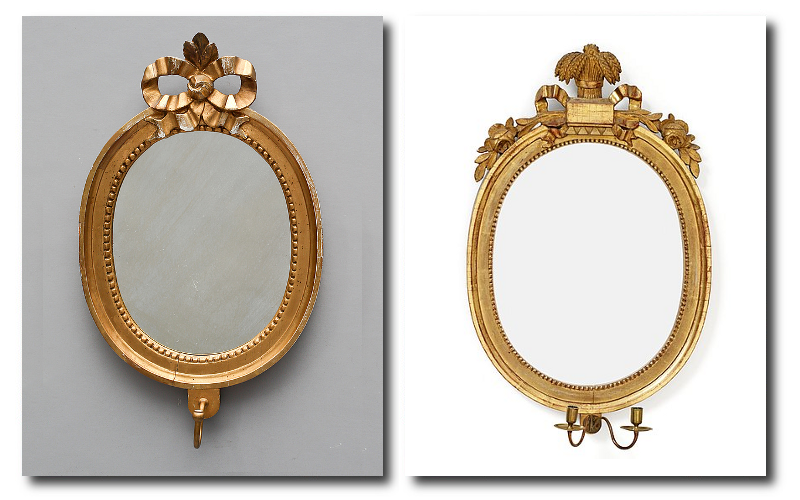




Quiet luxury inspired by 18th-century Sweden
Light - Patina - Heritage

Restoration Tools
- Matte Topcoat
- Pro Grade Brush Set
- Finishing Sealer In Matte
- Bronze Spray For Hardware
- Sticks To Everything Primer
- Dead Flat Varnish
- Stick To Everything - Matte Primer
- Transparent Aged Glaze
- Sticks To Everything Brown Primer
- Prima Transfers
- Dyke Brown Glaze
- Escutcheons
- Medallion Silicone Mold
- French Key Molds
- Portico Scroll
- Rusty Paint Finishes
Recent Posts
- 200 Swedish Antiques A Person Can Look For
- Rococo In The Nordic Countries
- For The Love Of Collecting Antiques – A Swedish Interior
- Gustavian Furniture – How to get the look – Ulla Kloster
- 3 Swedish Must Haves – Decorating A Home Around Swedish Antiques
- The Beautiful Wall Paintings Of von Echstedtska gården In Sweden
- 400 Professional Designers Picked Green As The New Color To Watch
- 5 Scandinavian Interior Design Tricks – Megan Slack
- 30 Gray Toned Paint Colors For Swedish Styled Interiors – Behr
- DIY Upper Kitchen Cabinets – Lindsay – White Buffalo Styling
- Bringing The Garden In For The Winter
- The Home Office – Why Not Make Yours Unique ?
- The Light And Airy Furniture Of Sweden
- Slipcovers Have Always Been Popular Through Time – Swedish Decorating
- The Couple Behind D. Larsson Interior and Antikhandel – Swedish Antiques
- 6 Colors You’ll Find In Every Scandinavian Home – Laura Barry
- 5 Decorating Mistakes Not To Make – By Gabrielle Savoie
- Designer Marshall Watson’s Scandinavian Newport Beach Home
- Designer Marshall Watson’s Scandinavian Summer House
- Swedish Inspired Kids Bedrooms
- 5 Kitchen Design Lessons You Can Learn from Scandinavian Interiors
- Jenny’s DIY Wide-Plank Plywood Flooring Studio Renovation
- Decor Mistakes All 20-Somethings Make
- Can I Stain Over Paint To Produce A Patina?
- Q&A With Swedish Designers Edie Van Breems and Rhonda Eleish
- How To Avoid Yellowed White Painted Furniture With General Finishes Products
- Colleen Martin, Founder of Swede Collection Tells Us Her Journey Of How She Began Reproducing Gustavian Furniture
- Expect To See More Warm Grays, Blues And Creams In Gustavian Decorating
- 8 Brands Of Gold Spray Paint Were Compared To Find The Best Color
- Essential Characteristics Of 18th Century Swedish Interiors
- Gustavian Style By Kristie Barnett
- 7 Places To Find Swedish Design For Toddlers
- Study Shows The Gustavian Period Has Defined All Tastes Through Time In Sweden
- Mix Old and New Like the Scandinavians Do- Chloe Taylor
- Swedish Furniture Design – What Makes The 1800’s So Obsessive
- 5 Pieces Of Wise Decorating Advice From Tricia Foley
- Impressive History Of Fine Swedish Table Linen
- Linen Has An Incredible History- Find Out Why……
- Life In 17th Century Norway & Sweden
- How To Select The Right Linen For Your Children’s Bedroom- Kids Room Decor Ideas
- Nordic Style Kids Bedroom Decor Ideas
- Decorator Tricia Foley’s Signature White Interiors
- 10 Tips From Interior Designer Furlow Gatewood
- Living In Norway- Norwegian Life In The 18th & 19th Centuries By Elisabeth Holte
- Investing In Mora Clocks – Expert Advice From Jo From Swedish Interior Design
- International Interior Decorating Magazines Worth Buying
- Swedish Council Of America Articles
- 5 Homes Decorated Around The Nordic Style
- Swedish Reproduction Furniture At Solgarden
- Behind The Rundale Palace in Latvia
- Nordic Style Historical Interior Decorating Books – Living Museums in Scandinavia
- Decorating Around Red- Historical Interior Design Ideas
- Florence De Dampierre Comments On Nordic Furniture In Sweden And Denmark
- 12 Designers Pick Their Favorite Paint Colors – House Beautiful
- 7 Of The Most Famous Swedish Furniture Designers And Decorators
- New Research Suggests Swedish Furniture In The 1700’s May Have Had Strong Colors
- Swedish Tripod Tilt-Top Candle Stand Tables
- Decorators Who Have Embraced The Nordic Style – 30+ Pictures
- A Look Behind Skogaholm Manor -18th century Swedish Decorating
- Decorating With Swedish Country Antiques- Darlene Peterson Buchanan
- 12 Interior Designers Pick Their Favorite Swedish Paint Colors
- 50+ Decorating Books Worth Looking At
- Swedish Decorating Inspirations In Yellow, Ivory And Beige- 50+ Pictures
- Decorating Around The Color Green – Swedish Style
- A Dallas, Texas Home Decorated Around The Swedish Style
- 3 Houses Decorated Around The Rustic Swedish Style
- Reproduction Distressed Furniture And Home Decor From Bliss Studio
- Buy The Swedish Style For Less
- 3 Swedish Style Homes Featured In Magazines
- Swedish Antiques From Debenham Antiques
- The History Behind Jean Bernadotte Otherwise Known As Karl Johan
- 5 Faux Wall Painting Techniques That Are Easier Than You Think
- Swedish Kids Rooms: 6 Ideas To Get The Look
- 5+ Nordic Homes Decorated Around White
- 10 Of The Best Tours In Sweden
- 3 Rustic Scandinavian Country Homes – Borrow Ideas From Norway and Denmark
- Spring Summer Checks and Florals For The Swedish Home
- 70 Swedish Furniture Pieces That Sell For Less- Swedish Decorating On A Budget
- Decorating With Blue: Swedish Style Decorating Ideas
- An Interview With Daniel Larsson- The Go-To Guy For Swedish Antiques
- 7 Scandinavian Country Decorating Books
- 75 Swedish Nordic Pinterest Pages! Oh Yes…More Eye Candy!
- 69 Inspiring Pictures Of Nordic Country Style Decorating
- 20 Scandinavian Gift Ideas
- 5 Ways To Add Life Into Worn-Out Furniture
- Mora Clocks: Investing In Swedish Heritage
- How To Decorate With Botanicals
- Buying Property In Sweden
- Get The Swedish Look By Installing Tongue And Groove Paneling
- The Lavish Interior Of The Swedish Häringe Castle
- The Swedish Wreta Gestgifveri Inn
- Paint It White He Says…. Washington Interior Designer Darryl Carter – Swedish Decorating
- 5 Pro Painting Tips For Black Furniture
- The Swedish Artist Carl Larsson
- A Guesthouse Decorated in The Swedish Style
- Swedish Furniture From Bukowski Market
- 216 Selections From Wallpaper Direct – Swedish Decorating
- A Look Behind The National Museum of Stockholm
- Antique Swedish Dealer Jane Moore’s Home Veranda Magazine
- A Swedish Collected Home In Upstate New York – Swedish Gustavian Decorating
- $100+ Solid Braided Rugs
- 60 Scandinavian Country Folk Art Books On Amazon
- 50 Examples Of Swedish Folk Country Interiors
- Designers Pick Their Favorite Gray Paints
- HOW TO: Paint Gustavian Finishes
- “Söderbo” A Home Untouched Since 1920
- Designer Martha Angus Loves Gustavian Style
- Les Indiennes Fabrics
- Decorating Secrets- 60 Quotes From The Best Experts In Design
- Swedish Kakelugn Stoves
- Helen Olsen’s Rungstedlund Home Revealed In Gods & Gardar Magazine
- The 1700 Collection Swedish Furniture
- Swedish Plaster Medallions
- The History Behind Empire Furniture From The Karl Johan Period -Liza Laserow
- Swedish Styled Wallpaper
- Nordic Style Drapery And Window Coverings
- The Gentle Palette of Swedish Antiques-Corey Amaro
- Custom Reproduction Swedish Furniture From Garbo Interiors
- 30 Spectacular Picks From Frantz Hemeleers Antiques
- Go Bold With Red- Part 1 Grand Sophisticated Interiors
- Go Bold With Red- Nordic Country Interiors
- The Baroque Style Of Switzerland
- Daniel Romualdez’s Swedish Montauk Home
- The Shocking History Behind “Emerald Green” Paint
- Stylish Looks For Slip-covering Your Furniture
- The Best 5 Websites For Purchasing Antique Hardware
- Fired Earth’s Anniversary Paint Collection
- Swedish Furniture Auctions -Uppsala Auktionskammare
- Louis Masreliez- The Designer Behind Gustav III’s Pavilion At Haga Park
- A Nordic Design Staple- The Swedish Kakelugn Tile Stove
- Swedish Antique Mirrors
- How To Decorate A Child’s Room In The Swedish Style
- Ruby Beets Swedish Rustic Home
- The Country Side Of Sweden- An All White Based Home
- Akerö in Södermanland, Sweden
- Krusenberg Herrgård: An 18th Century Swedish Luxury Hotel
- Wood Plank Flooring, A Swedish Design Must Have – Part 1
- Vinyl Plank Flooring, A Swedish Design Must Have – Part 2
- Laminate Wood Flooring, A Swedish Design Must Have – Part 3
- Plywood Plank Flooring, A Swedish Design Must Have – Part 4
- Painted Wood Flooring, A Swedish Design Must Have – Part 5
- The Romantic Baroque Style: Part 1- Stromholm
- The Romantic Baroque Style: Part 2 King Gustav Vasa
- The Romantic Baroque Style: Part 3 Skokloster & Steninge Palace
- The Romantic Baroque Style: Part 4 – A Collectors Home
- The Romantic Baroque Style: Part 5 Add Color
- Sweden’s Empire Decorated Rosersberg Palace
- The Most Beautiful Rococo Library In The World:The Anna Amalia Library
- 4 Resources For Swedish Decorating
- How Important Are Accent Pieces In A Swedish Home?
